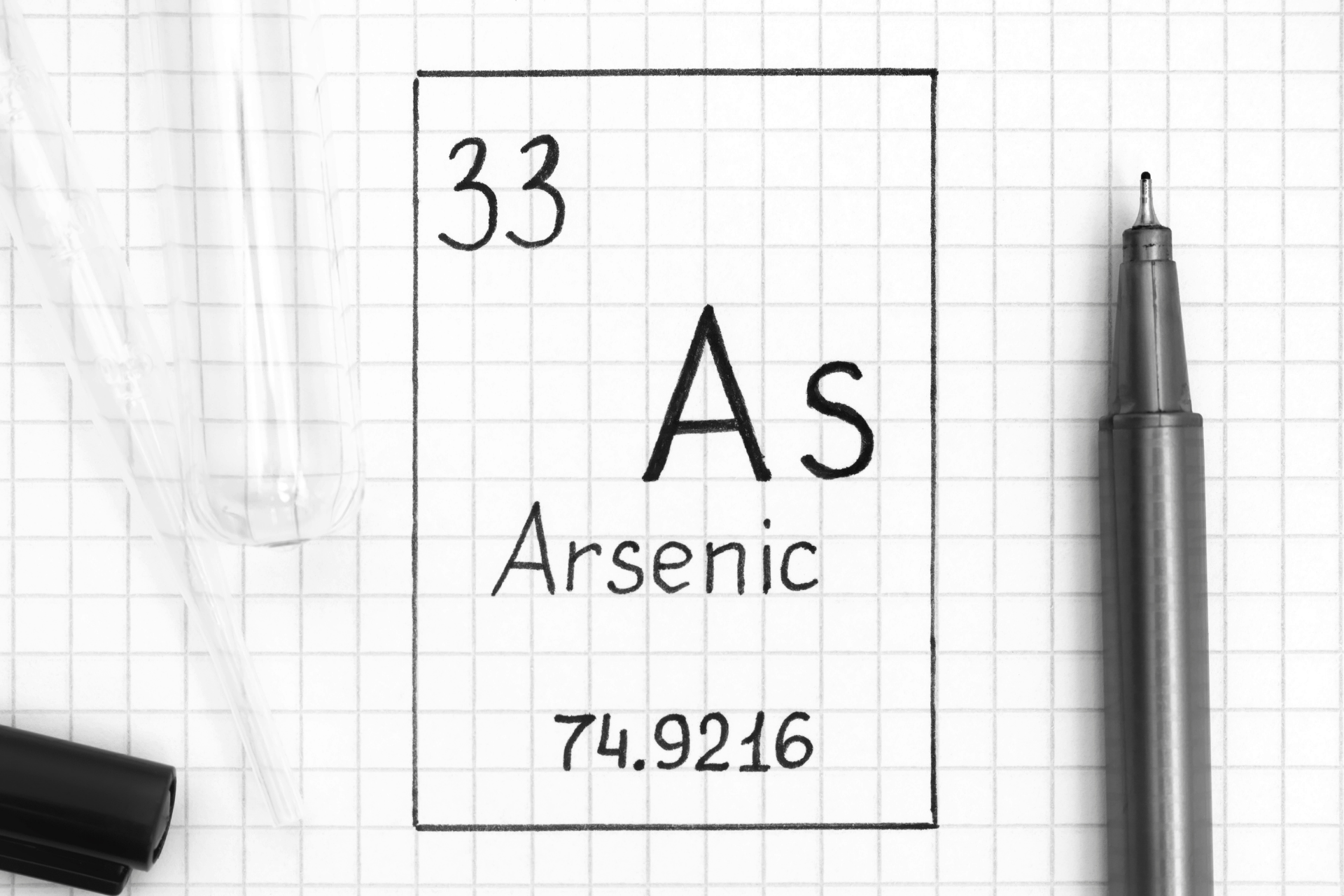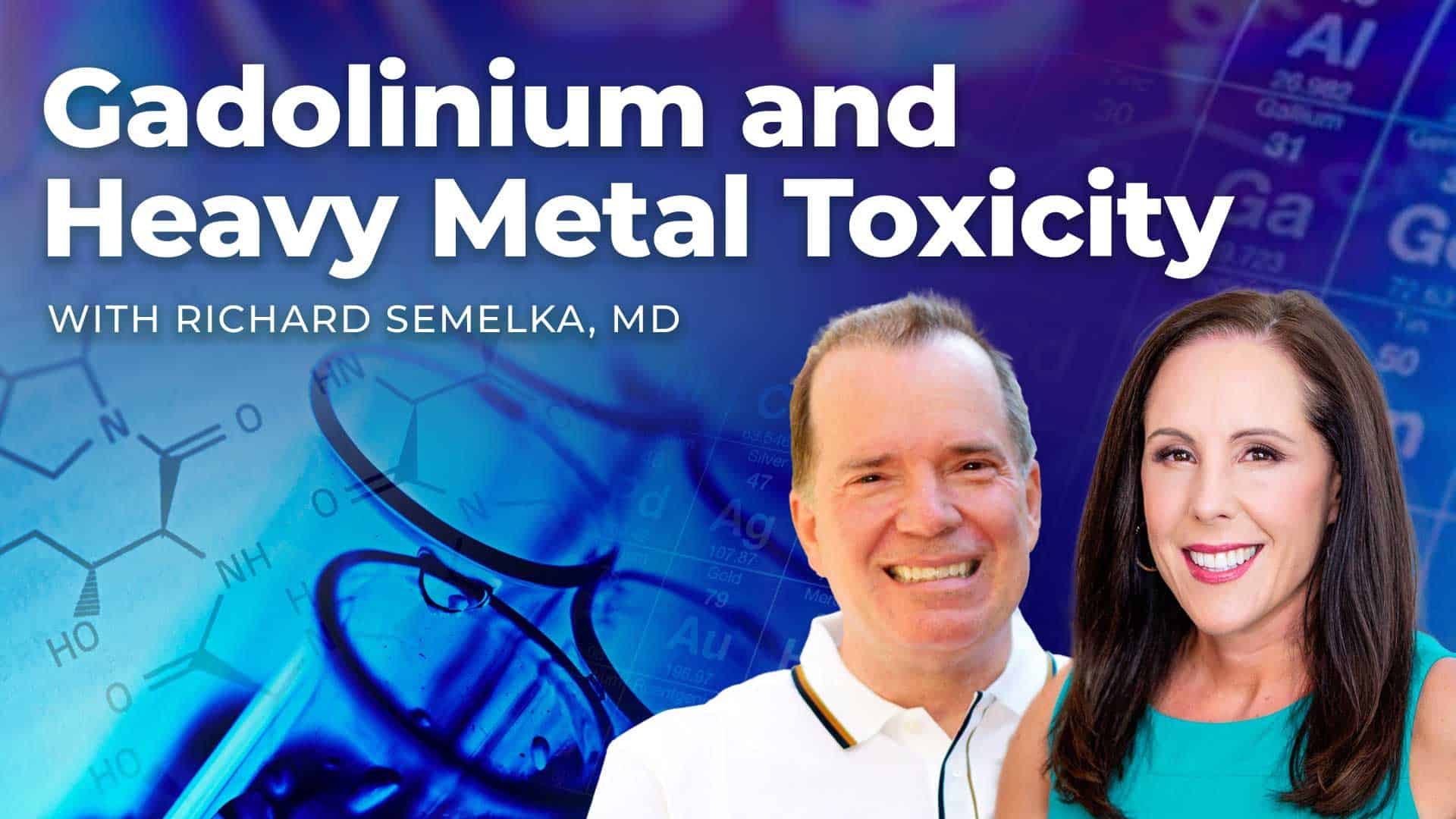In our modern world, we encounter a never-ending and ever-increasing barrage of toxins on a daily basis. The air we breathe, the water we drink, and the food we consume all have potentially harmful compounds lurking beneath the surface.
One of these toxins that’s been garnering more and more attention is a compound known as arsenic.
Today we’re going to dive into exactly what arsenic is, where it’s found, and why it poses such a threat to your health. And most importantly, we’ll cover some simple yet powerfully effective ways you can protect yourself from this catastrophic compound.
What Is Arsenic?
Arsenic is what is known as a metalloid – a type of chemical element that has properties similar to heavy metals. Arsenic occurs naturally in the environment but can be found in two distinct forms:1
- Organic arsenic compounds: Organic arsenic refers to arsenic that has combined with carbon and is found naturally in things like fish and seafood.
- Inorganic arsenic compounds: Inorganic arsenic refers to arsenic that has combined with elements other than carbon and is typically found in man-made chemical concoctions. Inorganic arsenic compounds are sometimes used in lumber preservation, pesticides, and certain manufacturing processes. Large amounts of inorganic arsenic can also be created through industrial processes like mining, fracking, and coal power plants.
But just because arsenic is natural doesn’t mean it can’t also be harmful. While organic arsenic can potentially be dangerous in large amounts, the real concern is elevated and/or prolonged exposure to inorganic forms of arsenic.
Why Is Arsenic Harmful to Humans?
Arsenic can pose a serious threat to your health. It exerts its toxic effects on your body by interrupting crucial cellular functions including:2
- Inactivating up to 200 enzymatic reactions
- Disrupting cellular energy pathways
- Inhibiting DNA replication and repair
- Generating reactive oxygen intermediates that can cause oxidative damage
- Hindering communication pathways between cells
While our bodies are well equipped to filter out a number of potentially harmful chemicals – including arsenic – the problem arises when exposure levels pass a certain threshold and your body is no longer able to counter the negative effects. Let’s take a look at some of the symptoms of arsenic poisoning.
Arsenic Poisoning Symptoms
The exact amount of arsenic exposure required to trigger an acute toxic reaction depends on the form of arsenic. Here’s a chart that breaks down the dosages of acute toxicity for different forms of arsenic. The LD50 refers to the approximate number of milligrams per kilogram of body weight it takes to trigger acute toxicity..

But acute arsenic poisoning isn’t the only way this element can be toxic. Arsenic poisoning can occur in two forms – acute toxicity and chronic toxicity. Let’s take a little deeper look at both of these.
Acute Arsenic Poisoning:
Acute arsenic poisoning occurs if you’re exposed to an elevated concentrated dose of arsenic that sends your body into an acute toxic reaction. It has a rapid onset, with symptoms typically appearing within 30 minutes and can deteriorate into a life-threatening situation if not addressed promptly. Symptoms of acute arsenic poisoning include:3
- Body tissues: A distinct garlic odor emanating from the breath and body tissues.
- Digestive tract: Gastrointestinal symptoms such as hypersalivation, abdominal cramping, pain, vomiting, and diarrhea. This excessive vomiting and diarrhea can even lead to hypovolemic shock. There may also be corrosion to the digestive tract causing chemical burns to the oral cavity and gastrointestinal bleeding.
- Heart: Alterations to the electrical conductivity in the heart causing arrhythmias like ventricular tachycardia, torsades de pointes, and/or ventricular fibrillation (aka having a heart attack).
- Lungs: Respiratory symptoms such as pulmonary edema, respiratory distress, bronchospasms, and even respiratory failure.
- Internal organs: Damage to your internal organs including acute kidney damage, an enlarged liver, jaundice, and/or pancreatitis.
- Nervous system: Neurological damage that can lead to seizures, encephalopathy, central nervous system depression, and can even result in a coma.
- Skin: Skin irritation that can cause rashes, ulcerations, and even gangrene.
- Circulatory system: Disruption of your blood cells, including the rupturing of red blood cells and the suppression of new blood cell generation.
Acute arsenic poisoning can quickly spiral into a life or death situation and requires immediate emergency intervention.
While acute arsenic poisoning is a serious and dangerous condition, it’s not the only way that arsenic poses a threat to your health. Chronic arsenic poisoning is a much less obvious but equally as deleterious condition.
Chronic Arsenic Poisoning:
Chronic arsenic poisoning is insidious. Over time arsenic can begin accumulating in your body, slowly wreaking havoc and causing side effects such as:4,5,6
- Skin: Skin changes such as lesions, keratosis or excessive skin growths on the palms and soles, hyperpigmentation, alopecia, and/or dermatitis.
- Digestive tract: Digestive issues like abdominal pain, diarrhea, anorexia, weight loss.
- Liver: Liver damage including jaundice, enlarged liver, and/or the development of portal fibrosis and cirrhosis.
- Heart: Heart problems such as coronary heart disease, myocarditis, pericarditis, hypertension, and/or peripheral arterial disease.
- Lungs: Respiratory issues like obstructive lung disease.
- Nervous system: Neurological changes including peripheral neuropathy, involuntary muscle spasms and movement, muscular weakness, and wasting.
- Endocrine system: Increased risk of diabetes and metabolic disorders.
- Cancer: Increased prevalence of cancers including lung, bladder, kidney, and liver cancer. Also increased risk of basal cell carcinoma and squamous cell carcinoma of the skin.
Chronic arsenic poisoning is particularly dangerous because it’s so sneaky. Over time arsenic can gradually chip away at your health while you’re blissfully unaware that this tiny toxin is hard at work undermining your health.
With such serious and insidious implications, you’re likely wondering exactly where arsenic might be hiding in your environment.
So, Where Is Arsenic Found?
The truth is, arsenic is found just about everywhere. Arsenic leaches into the ground through rocks and soil and can bind to numerous other elements – allowing it to spread far and wide. And while arsenic can potentially be inhaled or absorbed through your skin – particularly if you work in an industry that deals heavily with arsenic-containing chemicals – the two primary sources of arsenic exposure are through drinking water and through food sources.7
You see, this toxic chemical can seep into the ground, sneaking its way into groundwater and contaminating it with toxic levels of arsenic. And when you pour yourself a glass of water, all that arsenic makes its way directly into your body.
And this is further compounded when crops are grown in arsenic-contaminated soil and watered with arsenic-contaminated water.
So let’s take a look at some of the most common arsenic-contaminated foods.
What Foods Are High In Arsenic?
Because arsenic can be found nearly everywhere and is almost always present in both groundwater and soil, just about all food can potentially contain arsenic. And while all plants can absorb and hold onto arsenic, there are a few specific types that have been found to include higher levels. Let’s take a look at a few:8,9,10
- Arsenic in rice: Because rice is typically grown in fields that are flooded with large amounts of water and often in areas that have naturally higher levels of arsenic, rice is notorious for having elevated levels of arsenic.
- Arsenic in wine: Grapes grown in areas with high concentrations of arsenic in the soil can absorb this element. And then when the grapes are concentrated down into wine, it can further compound arsenic levels.
- Arsenic in vegetables, fruits, and juices: Vegetables, fruits, and concentrated juices can all contain higher levels of arsenic. This is due to the fact that many fruits and vegetables store the majority of their absorbed arsenic in the edible parts of the plants that we harvest and eat.
Considering that this list of high arsenic foods actually encompasses a significant amount of healthy foods, you’re probably wondering if that means you need to cut these foods out to protect yourself from arsenic exposure.
The answer is – absolutely not.
There are some much more efficient and less drastic ways to minimize your exposure to this harmful toxin. Let’s take a look at some steps you can take.
Ways to Lower Arsenic Consumption
When it comes to protecting yourself from arsenic, it requires a big-picture approach. While minimizing your arsenic consumption is important, it’s not the only way to keep yourself safe from this hazardous toxin. If you’re concerned about lowering your exposure to arsenic, here’s what I recommend:
Get Tested
It can be helpful to run some tests to establish a baseline of arsenic exposure. I recommend working with an experienced Integrative and Functional Medicine Doctor to properly run tests and interpret your results. There are a few ways to test arsenic levels.
If you live in a normal environment, you can test your urine first thing in the morning. Ideally, you’ll want to be below 7.0 μg arsenic/g creatinine. If you have a history of chronic exposure, taking a sample of your toenails may be able to give insight into your history of arsenic exposure.
It’s also a good idea to test the water in your area. Arsenic in water at levels greater than 20.0 ug/L is toxic for everyone. And arsenic in water greater than 10.0 ug/L is toxic for everyone, if there’s also another exposure – such as regularly eating chicken or rice.
Prioritize the Quality of Your Drinking Water
Contaminated drinking water is the number one source of arsenic exposure. So even if you live in an area that’s not known for high arsenic levels, it’s crucial to prioritize the quality of the water you’re consuming on a daily basis. The most effective way to do this is to invest in a quality water filtration system.
And when it comes to water filtrations systems, they’re not all created equally. You’ll want a purification system that has been rigorously tested and proven to remove contaminants – including arsenic.
My favorite water filters that I highly recommend are Boroux Water Filters and Clearly Filtered Water Filters. Both of these water purification systems are top-of-the-line and scientifically proven to remove hundreds of contaminants.
Keep Your Diet Fresh
When I say keep your diet fresh, I’m not only referring to fresh foods but also keeping your diet varied by frequently changing up the foods you eat.
Incorporate a variety of fresh fruits and veggies, satiating proteins, and healthy fats. Rotating the foods you eat ensures you're not consistently eating foods that are higher in arsenic and ensures you get the nutrients you need to support your natural detoxification systems.
It’s also a good idea to always thoroughly wash your fruits and vegetables before consuming them to remove any arsenic that may be clinging to the surface from the soil and water.
Minimize Your Toxic Burden
Your body is actually well-equipped to handle toxins in small amounts. Because the fact is, encountering potentially harmful compounds and toxins is entirely unavoidable, so your body has natural detoxification systems to neutralize and process these toxins out. The problem arises when the total amount of toxin exposure exceeds your body's capacity to deal with them – essentially clogging up and overworking your detox pathways.
Minimizing your overall toxic burden can help your body properly address the unavoidable exposure to arsenic and other toxic compounds. In addition to purifying your water and eating a healthy diet, some simple ways to minimize your toxic burden include:
- Purifying the air in your home and/or office
- Reducing exposure to harmful EMF’s
- Being conscious of the products you use on your skin and in your home
- Enhancing your detoxification capabilities through things like PEMF therapy or infrared saunas
- Incorporating detox-boosting supplements like glutathione, Activated B complex, and NAC
To learn more about some of the simplest and most effective ways to minimize your toxic burden and boost your body's detoxification pathways, head over and check out my article How to Boost Your Immune System by Reducing Your Toxic Burden.
Set Yourself up for Success
Arsenic toxicity can be insidious – slowly chipping away at your health over time. And taking steps to protect yourself from arsenic and other nocuous compounds is a crucial component of protecting your health – especially in this increasingly toxic world.
And while the idea of dangerous toxins lurking just about everywhere can seem scary, the truth is, you are not at the mercy of your environment. The good news is that you have the power to drastically influence your health and well-being through the day-to-day choices you make.
When it comes to your health and well-being you are in the driver’s seat. And that’s why I’m committed to empowering you with easy-to-understand and easy to implement tools – to help you take control and experience the vibrant health we all deserve.
So if you enjoyed this article and are looking for more ways to make your health a priority, I encourage you to head over and check out my blog – it’s full of resources just like this. And if you’re ready to take it to the next level, you can sign up for my newsletter by entering your name and email address in the form below.
Now it’s time to hear from you. Were you surprised to learn about the ways arsenic exposure can harm your health? What steps are you taking to protect yourself and your loved ones from our increasingly toxic environment? Leave your questions and thoughts in the comments below!
References:
- Arsenic and Cancer Risk
- Acute and chronic arsenic toxicity | Postgraduate Medical Journal (bmj.com)
- Arsenic Poisoning. Symptoms of arsenic poisoning and causes | Patient
- Chronic arsenic poisoning | DermNet NZ
- Arsenic Poisoning. Symptoms of arsenic poisoning and causes | Patient
- Arsenic Toxicity – an overview | ScienceDirect Topics
- Arsenic and Cancer Risk
- The Journey Starts Now (Sponsored) (webmd.com)
- Arsenic in Rice and Rice Products | Arsenic and You (dartmouth.edu)
- Arsenic in Fruits, Juices, and Vegetables | Arsenic and You (dartmouth.edu)
* These statements have not been evaluated by the Food and Drug Administration. The product mentioned in this article are not intended to diagnose, treat, cure, or prevent any disease. The information in this article is not intended to replace any recommendations or relationship with your physician. Please review references sited at end of article for scientific support of any claims made.



















4 Comments
Hi Dr Jill!!!!
You are absolutely right! I have high levels of arsenic! I live 4 miles from DFW airport, I always eat the saw cooked vegetables, I drink reverse osmosis water from our local water supply. I don’t take those supplements your talking about. NAC which Amazon just took off their website!!! I was wondering can I take charcoal to get rid of what I do have?? And if so how much should I take? Follow the bottle recommendations?
Thanks! Your biggest fan!
Dr. Jill,
I had arsenic show up in the 95th percentile on an HTMA. I had our water tested, and it’s not coming from our water supply. Is an HTMA a good measure for arsenic? I’m not sure how concerned to be.
Thanks!
Boil the rice in plenty of water, then discharge that water away.
Great information.
We are dealing with high arsenic in our water supply.
My research indicates that most filters do not remove arsenic from water and that an RO system is needed for that.
Share: